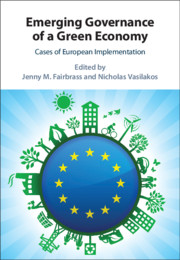Book contents
- Emerging Governance of a Green Economy
- Emerging Governance of a Green Economy
- Copyright page
- Contents
- Figures and Tables
- Contributors
- Preface
- Book Synopsis
- Acknowledgements
- Abbreviations
- 1 The Green Economy
- 2 The Green Economy
- 3 The Green Economy as Good Governance
- 4 On the Verge of a Second Revolution in the European Union’s Utilities Market for Energy Production?
- 5 ‘Great Expectations’
- 6 Overcoming Structural Disadvantages with Local Green Economies?
- 7 Shifting Models of Energy Companies towards Green Economy in Europe
- 8 Carbon Calculation and the Urban Green Economic Opportunity
- 9 The Green Economy
- Index
- References
7 - Shifting Models of Energy Companies towards Green Economy in Europe
Published online by Cambridge University Press: 20 January 2021
- Emerging Governance of a Green Economy
- Emerging Governance of a Green Economy
- Copyright page
- Contents
- Figures and Tables
- Contributors
- Preface
- Book Synopsis
- Acknowledgements
- Abbreviations
- 1 The Green Economy
- 2 The Green Economy
- 3 The Green Economy as Good Governance
- 4 On the Verge of a Second Revolution in the European Union’s Utilities Market for Energy Production?
- 5 ‘Great Expectations’
- 6 Overcoming Structural Disadvantages with Local Green Economies?
- 7 Shifting Models of Energy Companies towards Green Economy in Europe
- 8 Carbon Calculation and the Urban Green Economic Opportunity
- 9 The Green Economy
- Index
- References
Summary
The traditional model of European energy company has been characterised by big entities that usually play a relatively important role as national champions in terms of market share, assets value, vertical integration, political influence and employment volumes, among other factors. However, last decade has seen how these big dinosaurs are losing market power in favour of new actors. On one side Russian and Chinese competitors have started showing interest in the Western European energy sector, and they are developing purchasing strategies to acquire part of the business in different countries, taking advantages of the vulnerable financial position that many of these companies suffer. On the other side having been unable to change their business models away from the focus on fossil fuels into the renewable energies sector has made traditional companies lose market share in favour of a new model of companies, smaller in terms of assets but quite focused on a market segment with a privileged institutional support, particularly thanks to the European Union targets for 2020 on renewable energy. This chapter uses the framework of green economy as the one that approaches macroeconomic issues through innovative ways, promoting green investments through the most adequate regulatory measures, and considering green energy as one of the sectors where these investments should be focused. Bearing this in mind, the paper will try to point out the existing constraints to reach the new model of development (sustainable development, as promoted by a green economy) and also the barriers that energy companies impose themselves through old fashioned strategies that don’t take into consideration the wider demands from a much larger group of stakeholders in a changing society. It will also address the changing governance framework caused by recent political events such as Brexit and the shifting EU institutional discourse towards 2030 targets.
- Type
- Chapter
- Information
- Emerging Governance of a Green EconomyCases of European Implementation, pp. 107 - 126Publisher: Cambridge University PressPrint publication year: 2021

